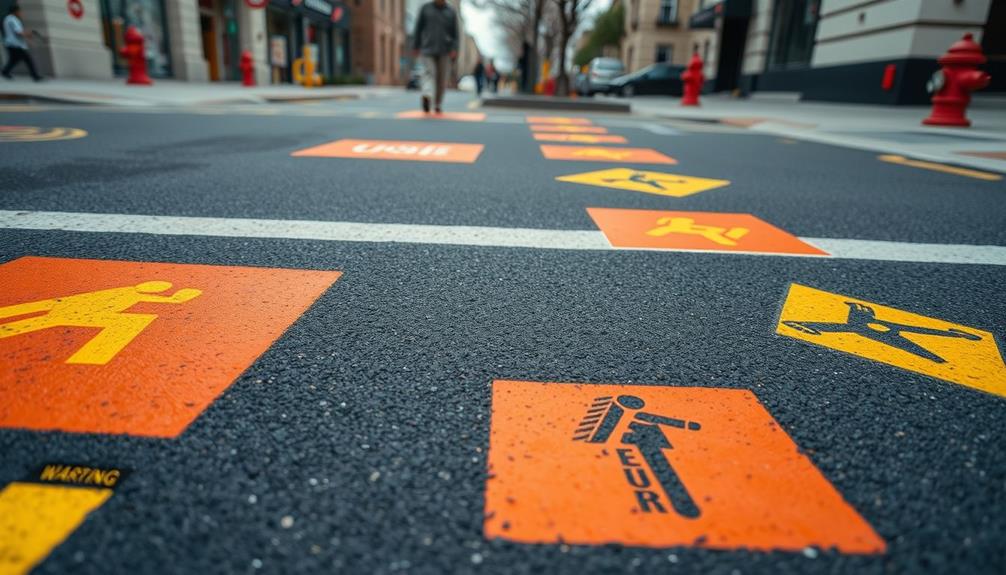Understanding urban rescue markings is essential for your safety during emergencies. These symbols quickly convey critical information. For example, a diagonal slash indicates an ongoing search, while an "X" within a square warns of dangerous areas. Familiarizing yourself with FEMA and INSARAG markings helps you assess hazards and navigate safer routes. Recognizing these signs can prevent confusion and allow you to make informed decisions when it matters most. This knowledge not only aids in the rescue process but also empowers you to stay calm in crises. By exploring more, you'll discover additional insights into these life-saving symbols.
Key Takeaways
- Familiarize yourself with the FEMA marking system, using diagonal slashes for ongoing searches and "X" for hazardous areas.
- Understand INSARAG markings: (G) indicates safe entry, while (N) signals dangerous entry points.
- Recognize that completed searches are marked with an "X" and additional team details for clarity.
- Knowing the meaning of rescue markings enhances safety and effective decision-making during emergencies.
- Community awareness of these symbols can reduce confusion and improve response efforts in crisis situations.
Overview of USAR Operations

When disasters strike, urban search and rescue (USAR) teams are ready to spring into action. These highly trained teams consist of over 140 skilled members organized into task forces, prepared to tackle the challenges posed by emergencies like earthquakes and floods.
You'll find that they're self-sufficient for the first 72 hours, equipped with over 60,000 pounds of specialized gear valued at $1.4 million. Integration of medical personnel guarantees immediate care during rescues, which helps manage chaotic situations effectively.
Regular drills and training improve their readiness and response times, while continuous communication among team members enhances safety. By coordinating with various agencies, USAR teams can maximize their effectiveness in saving lives during critical operations.
Importance of Rescue Markings

Effective communication during USAR operations can greatly impact the outcome of rescue efforts, and that's where rescue markings come into play.
These markings enhance decision-making, allowing teams to coordinate effectively and minimize risks. By using clear symbols, you can quickly identify search statuses, hazards, and completed searches.
For instance, a single diagonal slash indicates an ongoing search, while an "X" symbolizes a completed search with crucial information attached.
Familiarizing yourself with these markings not only boosts your safety but also streamlines the rescue process. Accurate markings help prevent confusion and guarantee every team member knows the situation at a glance.
Ultimately, understanding and utilizing rescue markings can markedly enhance your effectiveness during critical rescue operations.
FEMA Marking System Explained

Understanding the FEMA marking system is crucial for anyone involved in urban search and rescue operations. This system uses specific symbols to convey critical information about a structure's search status and hazards.
For instance, a single diagonal slash means an ongoing search, while an "X" within a square indicates danger, prohibiting entry. Once a search is completed, the "X" will often include additional details, such as the team's name and the date.
These clear markings help reduce confusion and enhance safety, allowing rescuers to communicate effectively. Familiarity with these symbols is important, as they streamline operations and guarantee that everyone involved knows the current conditions and risks, ultimately leading to more effective rescue efforts.
INSARAG Marking Significance

The INSARAG marking system plays an essential role in urban search and rescue operations by providing important information at entry points of structures.
When you encounter these markings, you can quickly assess the safety status of a building. Each marking indicates whether the entry is safe (G) or dangerous (N), helping you make informed decisions during chaotic situations.
The system also includes the team's name, ensuring accountability and clear communication among rescuers.
You'll find a 1-meter square box at entry points, which contains critical details like the search status and times of operations.
Understanding these markings can prevent confusion, reduce risks, and streamline rescue efforts, ultimately enhancing the effectiveness of the operation.
Common Symbols and Their Meanings

Familiarity with common symbols used in urban search and rescue operations can greatly enhance your ability to navigate emergency situations.
For instance, a single diagonal slash indicates an ongoing search, showing that rescuers are still active in that area. An "X" within a square warns of hazards, advising against entry. When a search is complete, you'll see an "X" accompanied by additional information, ensuring clear communication about the status.
The INSARAG markings provide essential details at entry points, denoting safe (G) or dangerous (N) entries, along with the team name and timestamps.
Understanding these symbols not only helps you stay safe but also aids in effective coordination during rescues, making your awareness critical in emergencies.
Impact on Rescue Coordination

Effective communication through urban search and rescue markings considerably enhances rescue coordination during emergencies.
When you understand these markings, you can quickly assess the situation and determine the safest routes for rescue operations. Each symbol conveys critical information about search status, hazards, and team accountability, enabling you to make informed decisions.
For instance, an ongoing search marked by a diagonal slash informs you that the area is still under investigation, while an "X" within a square warns you to keep out.
Community Awareness and Safety

Understanding urban rescue markings can greatly boost community awareness and safety during emergencies. When you recognize these symbols, you empower yourself and others to respond effectively. By familiarizing yourself with the markings, you can contribute to a safer environment for everyone. For example, knowing the symbols for designated evacuation routes or emergency assembly areas can guide people to safety in times of crisis. Understanding the markings for fallout shelter essentials can also ensure that necessary supplies and resources are readily available during emergencies. By educating ourselves and others about urban rescue markings, we can create a more prepared and responsive community.
Here are some key points to evaluate:
- Informed Decisions: Knowing the meanings of markings helps you make quick, informed choices during a disaster.
- Reduced Panic: Awareness can minimize confusion and panic, keeping emotions in check when every second counts.
- Community Support: Sharing knowledge fosters a sense of unity and support within your neighborhood.
- Enhanced Safety: Understanding these markings can save lives, ensuring you and your loved ones can navigate dangerous situations more safely.
Preparing for Emergency Situations

Recognizing urban rescue markings is just the first step in ensuring your safety during emergencies. To prepare effectively, stockpile supplies for at least 72 hours, including non-perishable food, water, and medical necessities. Reinforce your home with secure doors and windows to enhance safety. Familiarize yourself with local emergency marking systems like FEMA and INSARAG so you can navigate efficiently. Building strong community ties will provide mutual aid and support during crises.
| Preparation Tips | Key Actions |
|---|---|
| Stockpile Supplies | Gather food, water, and meds |
| Secure Your Home | Reinforce doors and windows |
| Learn Markings | Know FEMA and INSARAG systems |
| Build Community Ties | Foster connections with neighbors |
Frequently Asked Questions
How Can I Volunteer for USAR Teams in My Area?
To volunteer for USAR teams in your area, contact local emergency management agencies or search for community organizations. They often hold training sessions and welcome dedicated individuals enthusiastic to help in times of crisis.
What Are the Qualifications Needed to Join a USAR Task Force?
Did you know USAR teams typically have over 140 skilled members? To join a task force, you'll need specialized training, relevant experience, and often certifications in first aid, rescue techniques, or emergency management.
How Often Do USAR Teams Conduct Training Exercises?
USAR teams regularly conduct training exercises, often several times a month. These drills enhance your skills, guarantee readiness, and foster teamwork, helping you respond effectively during actual emergencies and improve overall operational efficiency.
Are There Age Restrictions for Participating in USAR Operations?
When it comes to age restrictions for USAR operations, you'll find that most teams prefer members to be at least 18. After all, they need mature individuals ready to jump into action during emergencies.
What Should I Do if I See USAR Markings at a Disaster Site?
If you see USAR markings at a disaster site, stay calm. Don't enter marked areas, follow instructions from rescue personnel, and provide assistance only if you're trained. Your safety is the priority during such operations.
Conclusion
You've learned how essential Urban Search and Rescue markings are in emergencies, but did you know that understanding these symbols could save lives? By recognizing and interpreting these signs, you don't just become a passive observer; you actively contribute to rescue efforts. In chaotic situations, your awareness can mean the difference between confusion and clarity. So, take the time to familiarize yourself with these markings—your knowledge could help guide responders and keep your community safe when it matters most.










